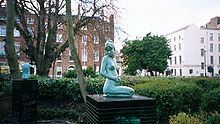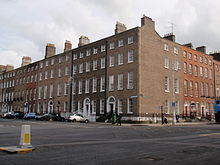- Merrion Square
-
Merrion Square (Irish: Cearnóg Mhuirfean) is a Georgian square on the southside of Dublin city centre. It was laid out after 1762 and was largely complete by the beginning of the 19th century. It is considered one of the city's finest surviving squares. Three sides are lined with Georgian redbrick townhouses; the West side abuts the grounds of Leinster House (seat of the Oireachtas), Government Buildings, the Natural History Museum and the National Gallery. The central railed-off garden is now a public park.
The Wellington Testimonial to commemorate the victories of Arthur Wellesley, 1st Duke of Wellington, was originally planned to be located in Merrion Square. However it was built in the Phoenix Park after opposition from the square's residents.
Until about the 1950s, the houses in the square were largely residential, but today most of them are used for office accommodation. The Irish Red Cross, the Central Catholic Library, the Irish Traditional Music Archive and the Irish Georgian Society have their headquarters on the square. The poet W. B. Yeats lived at No 82, and Daniel O'Connell at No 58, now home to the Keough-Naughton Center of the University of Notre Dame. The National Maternity Hospital is on the North terrace. A number of houses in the square have plaques with historical information on former notable residents, including A.E. (George William Russell) and Sheridan Le Fanu.
The recognised world class Irish American sculptor Jerome Connor, best known for his work Nuns of the Battlefield in Washington DC, designed the public art piece, "Eire" which is in the square.[1]
Until 1972 the British Embassy was based at No 39; however following the Bloody Sunday shootings in Northern Ireland a crowd of over 20,000 people converged on the site in protest and the building was burnt to the ground.[2]
The park in the square was called "Archbishop Ryan Park", after Dermot Ryan, the Catholic archbishop who transferred ownership to the city. The square was leased to the Archdiocese of Dublin by the Pembroke Estate in 1930 to permit the building of a Cathedral on the site to replace to the pro-Cathedral. Despite efforts over the next 20 years to advance the project, no progress was made and the site was transferred to the city of Dublin in 1974. Now managed by Dublin City Council, it contains a statue of Oscar Wilde, who resided in No. 1, Merrion Square from 1855 to 1876, many other sculptures and a collection of old Dublin lamp standards. In 2009, Dermot Ryan was criticised in the Murphy Report; in January 2010, Dublin City Council sought public views on renaming the Park.[3] In September 2010, the City Council voted to rename the park as Merrion Square Park.[4]
References
- ^ http://www.panoramio.com/photo/47776109
- ^ "1972: British embassy in Dublin destroyed". BBC News. 2 February 1972. http://news.bbc.co.uk/onthisday/hi/dates/stories/february/2/newsid_2758000/2758163.stm.
- ^ McGarry, Patsy (12 January 2010). "Councillor denies call to rename Archbishop Ryan Park". The Irish Times. http://www.irishtimes.com/newspaper/ireland/2010/0112/1224262120662.html. Retrieved 12 January 2010.
- ^ http://www.irishtimes.com/newspaper/ireland/2010/0915/1224278896831.html
External links
 Media related to Merrion Square at Wikimedia Commons
Media related to Merrion Square at Wikimedia Commons- Merrion Square Park (Archbishop Ryan Park) Dublin City Council
- Archiseek.com Doorways Archiseek.com Doorways
- Random sculpture and hideous orbs spoil Merrion Square Park
Squares of Dublin City Georgian Victorian Kenilworth Square · Dartmouth SquareOther St Stephen's Green · College Green · Leinster Square · Wilton Place · Belgrave Square · Ormond Square · Eaton Square · Pearse SquareDublin Parks Botanic Gardens · Bull Island · Bushy Park · Corkagh Park · Fairview Park · Fitzwilliam Square · Fr. Collins Park · Garden of Remembrance · Herbert Park · Irish National War Memorial Gardens · Iveagh Gardens · Marlay Park · Merrion Square · Mountjoy Square · People's Park · Phoenix Park · St Anne's Park · St. Enda's Park · St Stephen's GreenCategories:- Art gallery places
- Squares in Dublin (city)
- Streets in Dublin (city)
- Georgian architecture
- Parks in Dublin (city)
Wikimedia Foundation. 2010.


